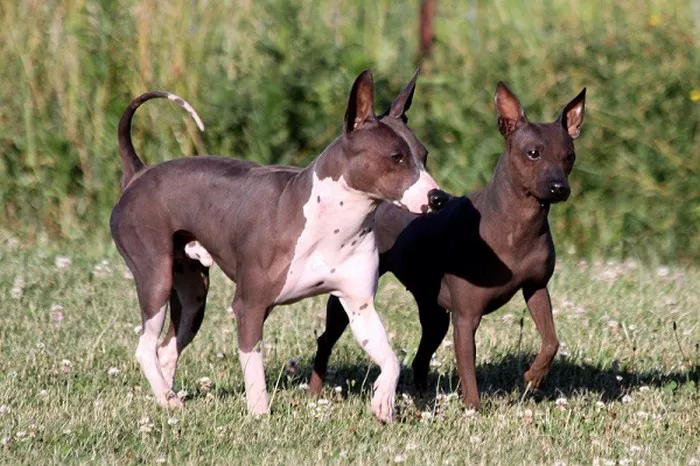Hairless dogs, such as the Chinese Crested and the Xoloitzcuintli, are unique and beautiful pets. However, caring for a hairless dog requires a bit of extra effort and attention. In this article, we will explore how to take care of a hairless dog, including their grooming needs, skin care, and overall health.
Grooming Needs:
Hairless dogs may not have fur, but they still require regular grooming to keep their skin healthy and clean. This includes:
Bathing: Hairless dogs should be bathed regularly, usually once every two weeks. Use a gentle shampoo that is designed for dogs, and be sure to rinse thoroughly to avoid any residue that could irritate their skin.
Moisturizing: Hairless dogs have sensitive skin that can become dry and flaky. Use a moisturizing lotion or oil to keep their skin soft and supple.
Nail Trimming: Hairless dogs’ nails grow quickly and should be trimmed regularly to avoid discomfort or injury.
Ear Cleaning: Hairless dogs are prone to ear infections, so it is important to clean their ears regularly using a gentle solution and cotton balls.
Skin Care:
Hairless dogs are more susceptible to skin problems than dogs with fur. This is because their skin is more exposed to the elements and can be easily irritated by clothing, furniture, and other materials. To care for your hairless dog’s skin, you should:
Protect their skin from the sun: Hairless dogs can get sunburned just like humans. Use a pet-safe sunscreen or keep them in the shade during peak sun hours.
Avoid using harsh chemicals: Harsh chemicals, such as flea treatments or cleaning products, can irritate your hairless dog’s skin. Use natural, pet-safe products whenever possible.
Monitor for skin problems: Keep an eye out for any signs of skin irritation, redness, or bumps. If you notice any changes in your dog’s skin, consult with your veterinarian.
Overall Health:
In addition to their grooming and skin care needs, hairless dogs require the same basic care as any other dog. This includes:
Feeding a healthy diet: Hairless dogs should be fed a high-quality, balanced diet that meets their nutritional needs.
Regular exercise: Hairless dogs need exercise to maintain a healthy weight and to keep their muscles strong.
Regular veterinary check-ups: Hairless dogs should see a veterinarian regularly for check-ups and vaccinations.
Dental care: Hairless dogs are prone to dental problems, so it is important to brush their teeth regularly and to provide them with dental chews or toys.
Conclusion:
Caring for a hairless dog requires a bit of extra effort and attention, but with proper grooming, skin care, and overall health care, your hairless dog can live a happy and healthy life. By following these tips and consulting with your veterinarian as needed, you can help keep your hairless dog looking and feeling their best.
FAQs
1. Are hairless dogs hard to take care of?
Hairless dogs, such as the American Hairless Terrier or the Chinese Crested, require regular care to maintain their skin health and overall well-being. While they may not need traditional grooming for fur, they require special attention to their skin, including regular baths, moisturizing, and protection from the sun to prevent sunburn and dryness. Additionally, hairless dogs may be more susceptible to skin issues such as acne or irritation, requiring careful monitoring and appropriate skincare.
2. How do you pet a hairless dog?
Petting a hairless dog should be done gently to avoid causing discomfort or injury to their sensitive skin. Use soft, gentle strokes rather than vigorous rubbing, and be mindful of any areas that may be particularly sensitive or prone to irritation. It’s also essential to wash your hands before and after handling a hairless dog to prevent the transfer of dirt, oils, or bacteria to their skin.
3. Do hairless dogs get cold easily?
Hairless dogs may be more susceptible to cold temperatures than their furry counterparts, as they lack the natural insulation provided by fur. It’s essential to keep hairless dogs warm and comfortable in colder weather by providing them with appropriate clothing, blankets, or heating pads, especially when outdoors. Additionally, limiting exposure to cold drafts and ensuring they have access to a warm, cozy environment indoors can help prevent discomfort and maintain their body temperature.
4. How do you clean a hairless dog?
Cleaning a hairless dog involves regular bathing with a mild, hypoallergenic shampoo to remove dirt, oils, and debris from their skin. Use lukewarm water and gentle massage motions to lather the shampoo and rinse thoroughly to prevent residue buildup. After bathing, pat the dog’s skin dry with a soft towel, taking care to avoid excessive rubbing or irritation. It’s also important to moisturize the skin with a hypoallergenic lotion or oil to help maintain hydration and prevent dryness. Regular skincare and grooming routines are essential for keeping a hairless dog’s skin healthy and free from irritation or infection.


